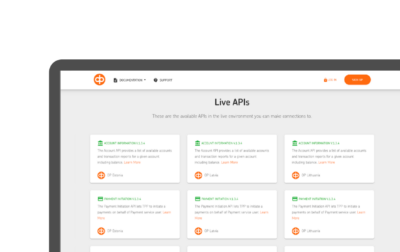OPEN BANKING API FOR FINTECH: OPPORTUNITIES, RISKS, AND BEST PRACTICES
Intro
Open banking lets consumers control their financial data and share it with third-party providers (TPPs). This gives those TPPs — smaller fintechs, startups, and other innovators — a chance to create better apps and services. The goal? More competition, which means better products for customers.
But once you start building, things get messy.
Each bank handles things a little differently — API formats, error codes, even how they define a transaction. Some data is delayed. Some is incomplete. Consent flows break if users blink the wrong way. And just when you think it’s stable, a regulator changes the rules.
Instead of building new features, your team ends up fixing bugs, dealing with random issues, and explaining to users why their accounts didn’t connect.
In this post, we’ll look at what causes the mess — and how to handle it so you can move faster with fewer surprises.
HOW OPEN BANKING APIS WORK
Open banking APIs let fintech apps access bank data — with the user’s permission.
- The user opens the app and agrees to share their bank data (this is called user consent).
- The app contacts the TPP to start the authorization process and get an initial token.
- The TPP redirects the user to their bank using a secure connection.
- The user securely logs into their bank account — usually through the bank’s app or site, just like when you log in with your Google account to access another app or service.
- The bank verifies the user’s identity, then sends a secure access token back to the TPP.
- The TPP uses access token to pull data like account balances, transactions, or start payments — depending on the access granted.
It’s about giving users control over their data — and giving you the tools to build better, safer banking experiences.
KEY BENEFITS OF OPEN BANKING API INTEGRATION
Now let’s look at the key benefits of open banking APIs — especially for fintech teams like yours.
INCREASED COMPETITION
Open banking makes it easier to access user financial data, so new companies can launch quickly. You’re no longer blocked by closed systems or lengthy bank integrations — you can build fast, flexible products that compete with big banks on user experience and speed.
FINANCIAL INNOVATION
Open banking APIs allow you to access data from multiple banks without needing to create separate connections for each one. This makes development faster and lets you focus on innovation, not on complex, bank-specific integrations.
BETTER CUSTOMER EXPERIENCE
In the end, users benefit the most. With open API integration, they get better products that simplify their lives. Now, they can connect their bank accounts instantly — no manual uploads, no waiting. You can show them real-time balances, categorize spending, and offer faster approval for things like loans or credit.

REGULATIONS AND OPEN BANKING API STANDARDS
As regulations change rapidly, we strongly advise you to stay updated and agile in your compliance efforts. In this blog, we’ll give you a quick overview of key regulations.
EUROPEAN UNION
The EU has a mature and regulated legal framework for open banking. It aims for standardization. Yet, differences in national rules and technical standards can create challenges.
- PSD2 mandates that banks share consumer data with third parties. PSD3 and the Payment Services Regulation (PSR), due in 2026, will update these rules.
- PSD2 is adopted by all 27 EU member states, with each country required to follow the core rules. However, there is flexibility in how they implement and enforce the regulations, which can lead to slight differences in regulations and timelines.
- While open finance APIs are standardized in principle, there is no single technical standard all banks must follow. For example, German banks typically use XS2A standards, while French banks follow STET standards.
UK
The UK is a global leader in open banking, ahead of the EU by 6–12 months. As a pioneer in open banking, it has many fintech companies and a growing number of consumers using these services. Its regulations are widely adopted across the country.
- The country’s regulations are probably the most advanced globally. The UK government continues to support and promote their adoption along with fintech growth.
- The Open Banking Standard, enforced by the Financial Conduct Authority (FCA), provides strict guidelines to protect consumers and promote innovation.
- The UK’s nine largest banks (the CMA9), which serve most UK consumers, had to create high-quality APIs, setting the standard for smaller banks to follow. As a result, this helped drive consistency across the sector.
USA
Unlike the EU and UK, open banking in the US is driven more by fintech innovation than by formal regulation. This leads to a patchwork of rules and practices.
- There are currently no federal mandates and no centralized standards. Instead, open banking works through market-driven agreements between banks and fintechs.
- The Consumer Financial Protection Bureau (CFPB) is working on creating official rules, with a focus on data privacy and security.
- Until then, most banks choose to take part voluntarily through partnerships with fintech companies.
OPEN BANKING API EXAMPLES
1.
ACCOUNT AGGREGATION
Account aggregation helps your users see all their financial info in one place — from checking and savings to credit cards and loans. Instead of jumping between apps, they get a clean, real-time view right inside your product.
Why does it matter? Because it makes money management simple. Users can track spending, check balances, and get a better sense of where they stand — without the friction.
Under the hood, it’s all powered by open banking APIs. These APIs let you pull in user-permissioned data directly from banks in a secure and standardized way.
Examples: Mint, Yolt, MoneyDashboard.
2.
INSTANT BANK PAYMENTS
Payment initiation (aka instant bank payments) lets your users pay straight from their bank accounts.
They just approve the payment in their banking app, and the money moves instantly from their account to the merchant. No card numbers to type, no manual transfers to track. It’s clean, fast, and secure.
On the backend, open banking APIs let you safely connect to the user’s bank and kick off the payment — with full consent and no need to store sensitive info.
Examples: Klarna, TrueLayer.
3.
CREDIT SCORING
Open banking makes credit scoring smarter.
Instead of relying on old-school credit reports, lenders can look at real transaction data — income, spending habits, bill payments — to see how someone really manages their money.
This helps people with little or no credit history. If they’ve been handling their finances well, open banking data can show that and give them a better chance of getting approved.
Open banking APIs let you securely connect to users’ bank accounts and pull data on their financial behavior to assess creditworthiness.
Examples: Credit Karma, Tully.
4.
TRANSACTION CATEGORIZATION
Transaction categorization helps your users understand where their money goes — fast.
Instead of showing a long list of raw transactions, you group them into categories like groceries, rent, or travel. That way, users get a clean, organized view of their spending.
It makes budgeting easier, helps people spot patterns, and even catch things like forgotten subscriptions or double charges.
To build this, you pull real-time data using open banking APIs, then run it through a categorization engine — often using machine learning — to sort everything into buckets automatically.
Examples: Emma, YNAB, Snoop.
Consult Touchlane on your fintech product
CHALLENGES AND SECURITY CONSIDERATIONS IN OPEN FINANCE APIS
1.
DATA PRIVACY
In the world of open banking and fintech, data privacy is becoming a bigger concern. Recent stats show a 15% rise in complaints about how financial companies handle personal data, with the financial sector receiving the most complaints. People are uneasy about how their financial info is being used.
The rise in complaints comes as companies like Revolut and Zilch look to make money by using customers’ data for targeted ads. This has many worried about how much of their personal financial habits might be exposed — even if the data is meant to be anonymized. And with the threat of data leaks or breaches, people’s trust is on the line.
Karla Prudencio Ruiz from Privacy International puts it simply: consumers need to have a real choice when it comes to sharing their data. She says, “You need to be able to say OK, I don’t want to. What’s my option? And if the option is you won’t get the service, then that’s not consent.”
2.
FRAUD PREVENTION
The 2024 report from Open Banking Limited (UK) shows that fraud in open banking is lower by volume than in other payment types, mainly because of strong customer checks.
But the value of fraud is higher, since open banking is often used for bigger payments. Plus, APP (Authorised Push Payment) fraud is more common — people are tricked into sending money themselves.
Examples include fake investment offers, scammers pretending to be from banks or a tax authority, or ads on social media promoting crypto deals that turn out to be fake. Many of these scams start on social platforms, where fraudsters use messages or fake profiles to gain trust and convince people to send money.
3.
API SECURITY
In open banking and fintech, APIs handle sensitive financial data and initiate transactions. Without proper security, fintech apps built on open banking APIs can be easy targets for hackers.
A 2024 Forbes survey found that 20% of cybersecurity professionals in finance and insurance reported API-related breaches — often caused by weak authentication, exposed data, or missing rate limits. Such issues not only risk personal data, but also damage customer trust and threaten regulatory compliance.

TOP 8 TIPS ON OPEN BANKING API INTEGRATION
Your guide to open bank API integration and development will depend on things like regulations, tech setup, and who is your target audience.
But there are key things to keep in mind that are essential for every project involving open banking APIs.
TIP 1. GET LEGAL SUPPORT EARLY
Start by mapping out the regulations for each market you plan to operate in — PSD2 in the EU, OBIE standards in the UK, and evolving CFPB guidelines in the US. Compliance is non-negotiable, and each jurisdiction has slightly different interpretations.
TIP 2. BUILD WITH SECURITY & PRIVACY BY DESIGN
Your API must protect customer data at all times. Use strong encryption, OAuth 2.0 for authentication, and robust consent flows. Don’t just focus on transit — encrypt data at rest too. Regularly audit keys and access controls.
TIP 3. DESIGN FOR STANDARDIZATION & FLEXIBILITY
Build APIs that align with industry frameworks (like the Open Banking Standard or the Berlin Group Framework), but keep them flexible to integrate with different banking systems. Expect differences across banks and regions — modular architecture helps.
TIP 4. PROVIDE SEAMLESS TECHNICAL INTEGRATION
When integrating with third-party banks or aggregators, test thoroughly across sandbox and live environments. Use API gateways and management tools to control traffic, monitor usage, and enforce policies.
TIP 5. ESTABLISH CLEAR CONSENT FLOWS
Open banking regulation is based on the principle of user consent given to TPPs. And user trust starts with transparency. Make consent collection easy, explicit, and revocable. Your UX should clearly explain what data is shared, with whom, and why — for example, whether it’s account balances for budgeting tools, transaction history for credit scoring, or access to initiate payments.
TIP 6. SET UP SMART MONITORING & COMPLIANCE CHECKS
Compliance doesn’t end after launch — regulations evolve. Track every API call, monitor for anomalies, and keep an audit trail. Automate reporting wherever possible to reduce overhead.
TIP 7. EDUCATE USERS AND BUILD TRUST
Your tech might be great, but people will only use it if they trust it. Make onboarding simple, answer common questions clearly, and explain how you keep their data safe. Let them know they’re in control. Being open builds trust — and trust builds loyalty.
TIP 8. OPTIMIZE PERFORMANCE AND SCALE
Open banking relies on a lot of data, so it’s important to ensure your system runs fast, stays up, and can handle growth. Use caching to speed things up, add retry logic to fix errors, and set up fallbacks to keep things working if something goes wrong. This will help prevent downtime and ensure a better user experience.
Conclusion
Open banking runs on two key ideas: users give consent to share their data, and TPPs use that data to build better fintech products.
But beyond that, it’s still a fragmented space — with different laws, API standards, and technical approaches across regions.
The market’s growing fast, but staying ahead means more than just following the rules. You need to build trust. Be clear about what data you collect, why you need it, and how it’s used — after all, it’s sensitive financial info users are choosing to share with you.
The content provided in this article is for informational and educational purposes only and should not be considered legal or tax advice. Touchlane makes no representations or warranties regarding the accuracy, completeness, or reliability of the information. For advice specific to your situation, you should consult a qualified legal or tax professional licensed in your jurisdiction.
RELATED SERVICES
CUSTOM MOBILE APP DEVELOPMENT
If you have an idea for a product along with put-together business requirements, and you want your time-to-market to be as short as possible without cutting any corners on quality, Touchlane can become your all-in-one technology partner, putting together a cross-functional team and carrying a project all the way to its successful launch into the digital reality.
If you have an idea for a product along with put-together business requirements, and you want your time-to-market to be as short as possible without cutting any corners on quality, Touchlane can become your all-in-one technology partner, putting together a cross-functional team and carrying a project all the way to its successful launch into the digital reality.
We Cover
- Design
- Development
- Testing
- Maintenance




